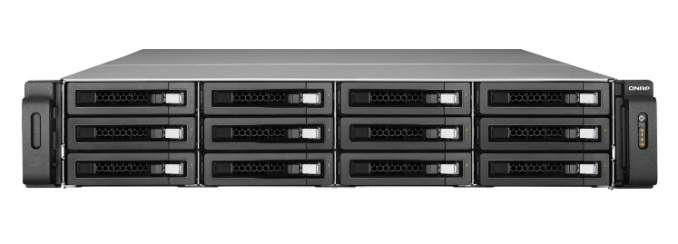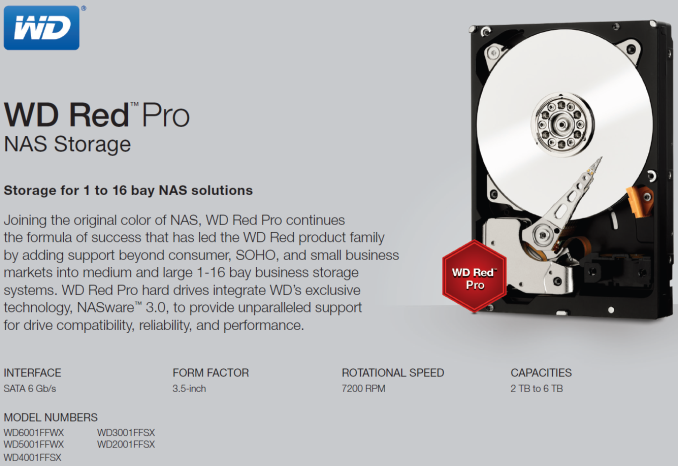
Original Link: https://www.anandtech.com/show/9606/wd-red-pro-6-tb-review-a-nas-hdd-for-the-performance-conscious
WD Red Pro 6 TB Review - High Performance NAS HDD Gets a Capacity Bump
by Ganesh T S on September 7, 2015 8:00 AM EST- Posted in
- Storage
- HDDs
- NAS
- Western Digital

Introduction and Testbed Setup
Despite the increasing affordability of SSDs, hard drives continue to remain the storage medium of choice for applications where capacity and cost factors outweigh performance requirements. Specialty drives have become the order of the day, with hard drive vendors having separate lineups to target different market segments such as desktop computers, SOHO NAS units, SMB / SME NAS units and NVRs. Western Digital was the first to introduce a 6 TB drive in the SOHO NAS drive space, but Seagate came back a few months later with a souped-up 6 TB Enterprise NAS HDD targeting the SMB / SME NAS units. Last month, Western Digital finally released the 6 TB version of the WD Red Pro for the SMB / SME NAS units.
We have already had comprehensive coverage of a number of 4 TB NAS drives and a few 6 TB ones. As more high-capacity drives started getting into the market, we started reviewing them standalone. The results from our evaluation of the WD Red Pro 6 TB is presented in this review.
The correct choice of hard drives for a NAS system is influenced by a number of factors. These include expected workloads, performance requirements and power consumption restrictions, amongst others. In this review, we will discuss some of these aspects while comparing the WD Red Pro against other drives targeting the NAS market. The list of drives that we will be looking at today is listed below.
- Western Digital Red Pro [ WDC WD6001FFWX-68Z39N0 ]
- HGST Deskstar NAS [ HDN726060ALE610 ]
- Seagate Enterprise NAS HDD 6 TB [ ST6000VN0001-1SF17Z ]
- Western Digital Red 6 TB [ WDC WD60EFRX-68MYMN0 ]
- Seagate Enterprise Capacity 3.5 HDD v4 6 TB [ ST6000NM0024-1HT17Z ]
- HGST Ultrastar He6 6 TB [ HUS726060ALA640 ]
Prior to proceeding with the actual review, it must be made clear that the above drives do not target the same specific market. For example, the HGST Deskstar NAS and WD Red are for 1- 8 bay NAS systems in the tower form factor. The WD Red Pro is meant for rackmount units up to 16 bays, but is not intended to be a replacement for drives such as the WD Re.
Testbed Setup and Testing Methodology
Our NAS drive evaluation methodology consists of putting the units to test under both DAS and NAS environments. We first start off with a feature set comparison of the various drives, followed by a look at the raw performance when connected directly to a SATA 6 Gbps port. In the same PC, we also evaluate the performance of the drive using some aspects of our direct attached storage (DAS) testing methodology. For evaluation in a NAS environment, we configure three drives of each model in a RAID-5 volume and process selected benchmarks from our standard NAS review methodology. Since our NAS drive testbed supports both SATA and SAS drives, but our DAS testbed doesn't, only SATA drives are subject to the DAS benchmarks.
We used two testbeds in our evaluation, one for benchmarking the raw drive and DAS performance and the other for evaluating performance when placed in a NAS unit.
| AnandTech DAS Testbed Configuration | |
| Motherboard | Asus Z97-PRO Wi-Fi ac ATX |
| CPU | Intel Core i7-4790 |
| Memory | Corsair Vengeance Pro CMY32GX3M4A2133C11 32 GB (4x 8GB) DDR3-2133 @ 11-11-11-27 |
| OS Drive | Seagate 600 Pro 400 GB |
| Optical Drive | Asus BW-16D1HT 16x Blu-ray Write (w/ M-Disc Support) |
| Add-on Card | Asus Thunderbolt EX II |
| Chassis | Corsair Air 540 |
| PSU | Corsair AX760i 760 W |
| OS | Windows 8.1 Pro |
| Thanks to Asus and Corsair for the build components | |
In the above testbed, the hot swap bays of the Corsair Air 540 have to be singled out for special mention.
They were quite helpful in getting the drives processed in a fast and efficient manner for benchmarking. For NAS evaluation, we used the QNAP TS-EC1279U-SAS-RP. This is very similar to the unit we reviewed last year, except that we have a slightly faster CPU, more RAM and support for both SATA and SAS drives.
The NAS setup itself was subjected to benchmarking using our standard NAS testbed.
| AnandTech NAS Testbed Configuration | |
| Motherboard | Asus Z9PE-D8 WS Dual LGA2011 SSI-EEB |
| CPU | 2 x Intel Xeon E5-2630L |
| Coolers | 2 x Dynatron R17 |
| Memory | G.Skill RipjawsZ F3-12800CL10Q2-64GBZL (8x8GB) CAS 10-10-10-30 |
| OS Drive | OCZ Technology Vertex 4 128GB |
| Secondary Drive | OCZ Technology Vertex 4 128GB |
| Tertiary Drive | OCZ Z-Drive R4 CM88 (1.6TB PCIe SSD) |
| Other Drives | 12 x OCZ Technology Vertex 4 64GB (Offline in the Host OS) |
| Network Cards | 6 x Intel ESA I-340 Quad-GbE Port Network Adapter |
| Chassis | SilverStoneTek Raven RV03 |
| PSU | SilverStoneTek Strider Plus Gold Evolution 850W |
| OS | Windows Server 2008 R2 |
| Network Switch | Netgear ProSafe GSM7352S-200 |
Thank You!
We thank the following companies for helping us out with our NAS testbed:
- Thanks to Intel for the Xeon E5-2630L CPUs and the ESA I-340 quad port network adapters
- Thanks to Asus for the Z9PE-D8 WS dual LGA 2011 workstation motherboard
- Thanks to Dynatron for the R17 coolers
- Thanks to G.Skill for the RipjawsZ 64GB DDR3 DRAM kit
- Thanks to OCZ Technology for the two 128GB Vertex 4 SSDs, twelve 64GB Vertex 4 SSDs and the OCZ Z-Drive R4 CM88
- Thanks to SilverStone for the Raven RV03 chassis and the 850W Strider Gold Evolution PSU
- Thanks to Netgear for the ProSafe GSM7352S-200 L3 48-port Gigabit Switch with 10 GbE capabilities.
Specifications and Feature Set Comparison
Prior to getting into the performance evaluation, we will take a look at the specifications of the WD Red Pro 6 TB and see how it compares against the other NAS-specific hard drives that we have looked at before.
The WD Red Pro 6 TB sports a SATA III (6 Gbps) interface. As is customary for the high capacity drives in this market segment, it can only emulate 512-byte sectors (natively 4K). The interesting aspect is the presence of a 128 MB cache similar to the Seagate and HGST drives, and unlike the WD Red. The obvious selling point for its price target is the 7200 RPM speed, which should easily give it the lead in most benchmarks over the WD Red. The other aspects (such as the URE ratings, MTBF, warranty etc.) are as expected for a drive targeting SMBs and SMEs. The table below presents the data for the drive against the others in our evaluation database.
| Comparative HDD Features | ||
| Aspect | ||
| DMA Setup Auto-Activate | Supported; Disabled | Supported; Disabled |
| Extended Power Conditions | Supported; Disabled | Supported; Disabled |
| Free-Fall Control | Not Supported | Not Supported |
| General Purpose Logging | Supported; Enabled | Supported; Enabled |
| In-Order Data Delivery | Not Supported | Not Supported |
| NCQ Priority Information | Supported | Supported |
| Phy Event Counters | Supported | Supported |
| Release Interrupt | Not Supported | Not Supported |
| Sense Data Reporting | Not Supported | Not Supported |
| Software Settings Preservation | Supported; Enabled | Supported; Enabled |
| Streaming | Not Supported | Not Supported |
| Tagged Command Queuing | Not Supported | Not Supported |
Performance - Raw Drives
Prior to evaluating the performance of the drives in a NAS environment, we wanted to check up on the best-case performance by connecting one of them directly to a SATA 6 Gbps port. Using HD Tune Pro 5.50, we ran a number of tests on a raw drives. The following screenshots present the results for the WD Red Pro. Corresponding images for similar drives that have been evaluated previously are also provided in the drop-down box for easy comparison.
Sequential Reads
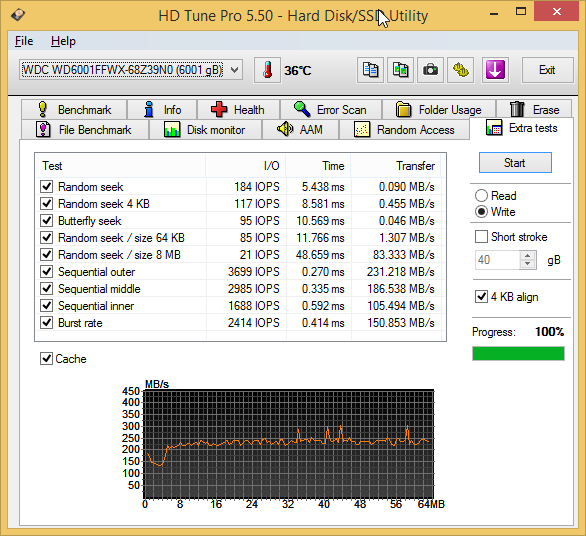
Single Client Access - DAS Benchmarks
The WD Red Pro was connected to a 6 Gbps SATA port off the PCH in our DAS testbed. After formatting in NTFS, it was subject to our DAS test suite. While processing our DAS suite, we also recorded the instantaneous transfer rates and temperature of the drive. Compared to other NAS drives at the same capacity point, write transfers show higher instantaneous speeds due to a combination of the firmware and the 128 MB cache inside the disk. However, sustained write rates are comparable to other 6TB drives. The temperature of the unit at the end of the transfers, despite being blow 45C, is higher than any of the other drives at the same capacity point.
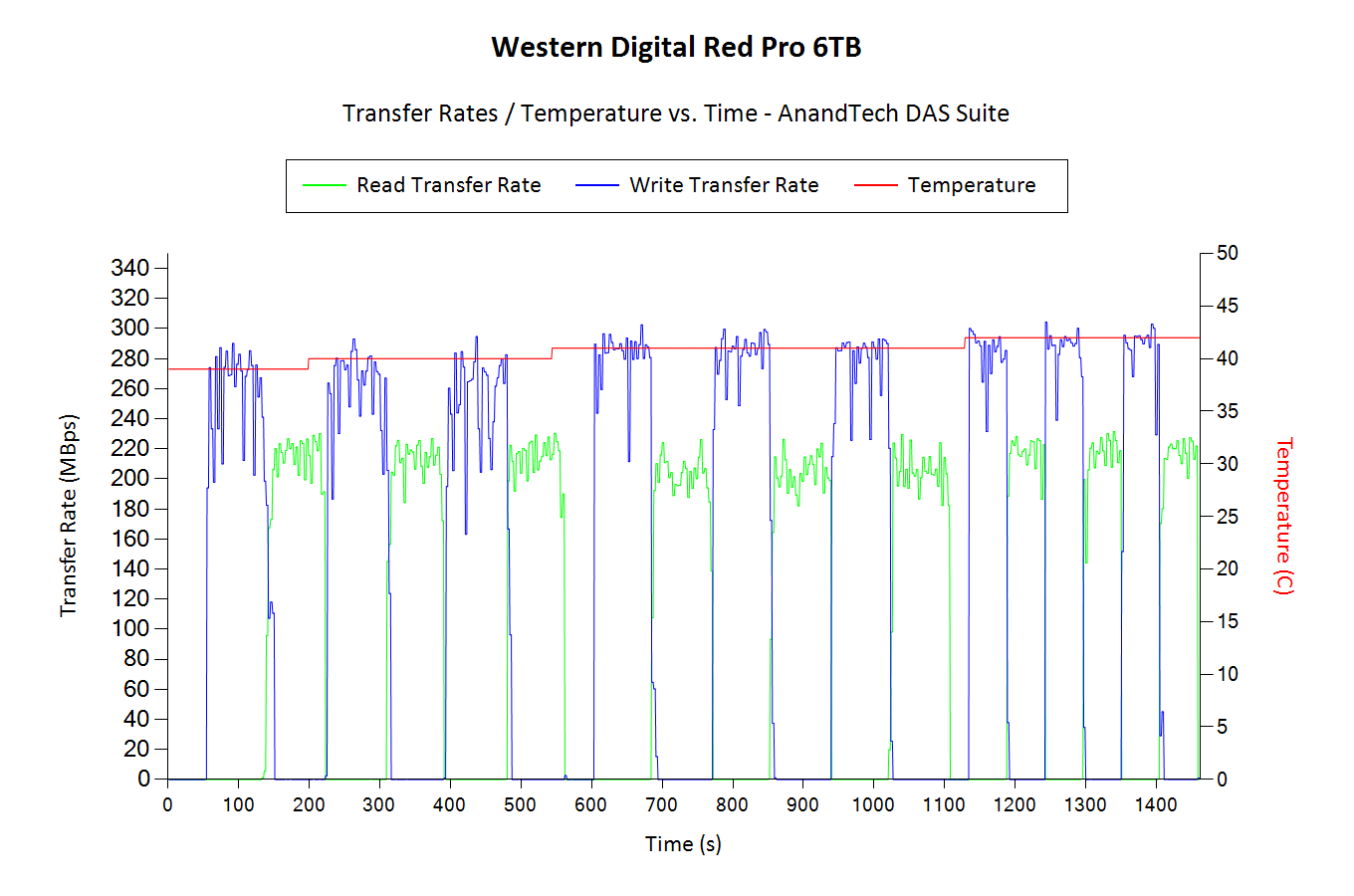
The graphs below present the average transfer rates for the various workloads and how they compare against other HDDs of the same capacity that have been evaluated before.

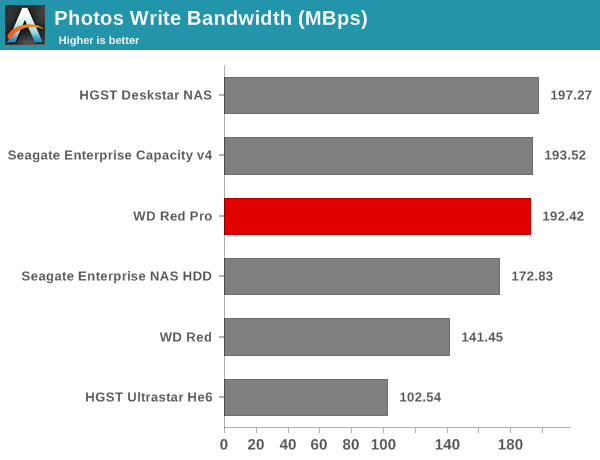
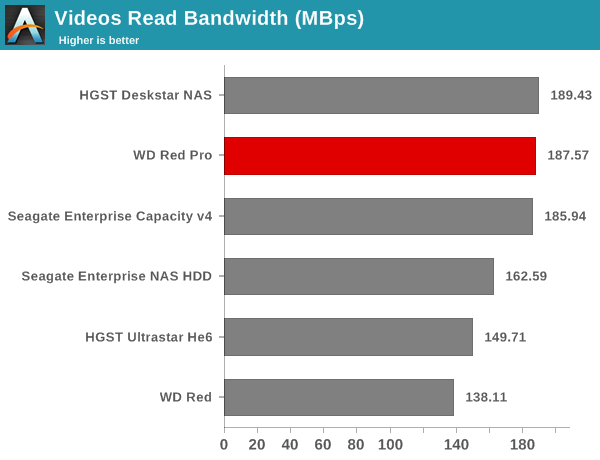
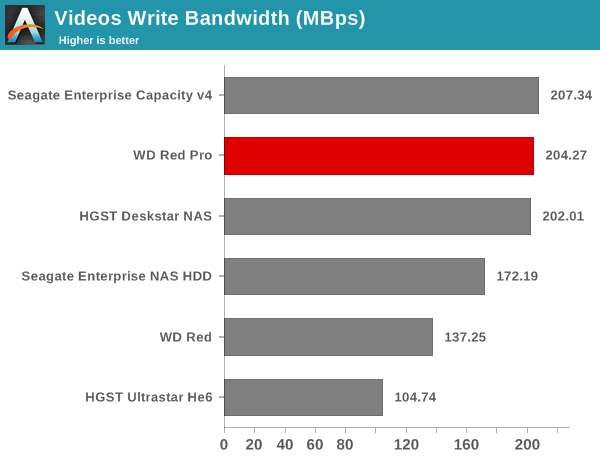
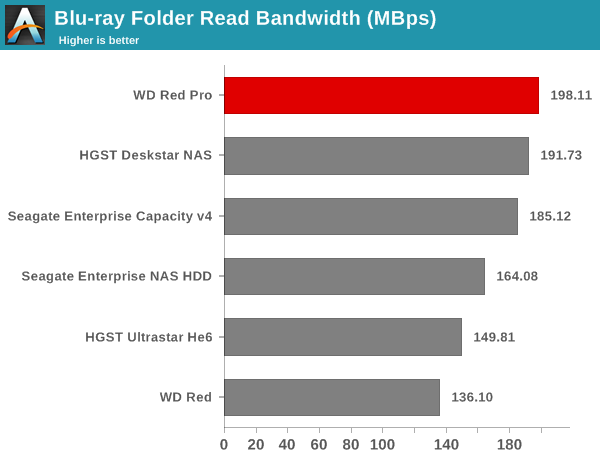
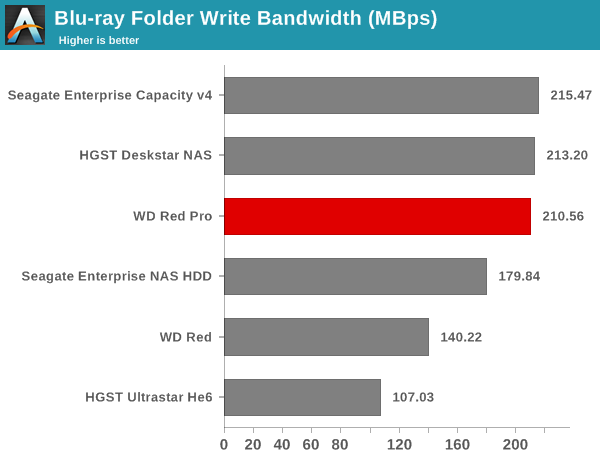
PCMark 8 Storage Traces
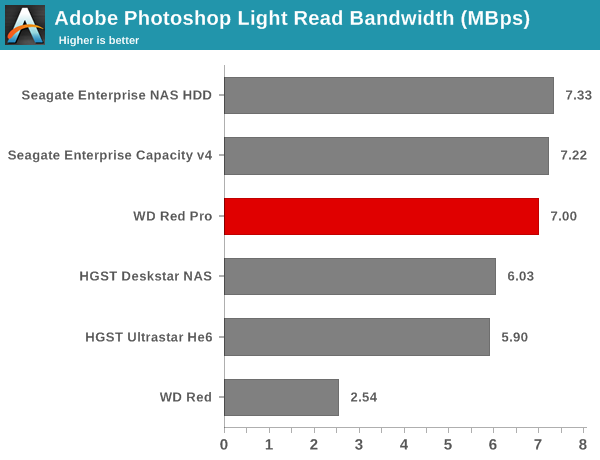
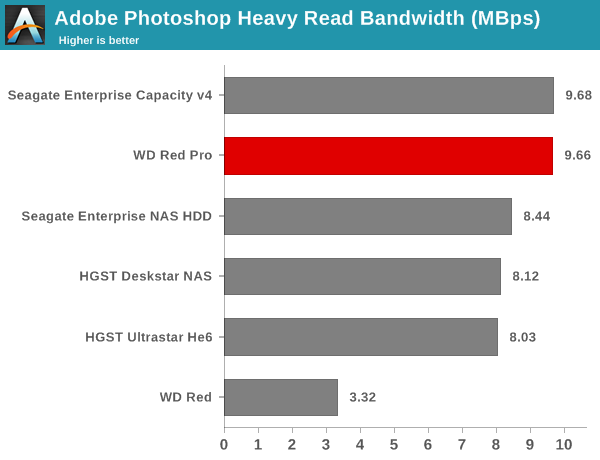
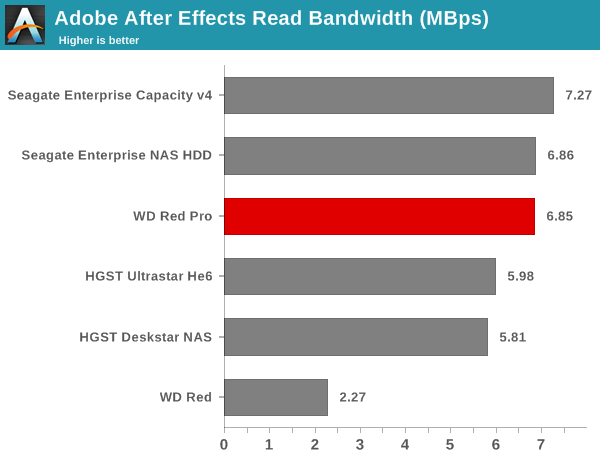
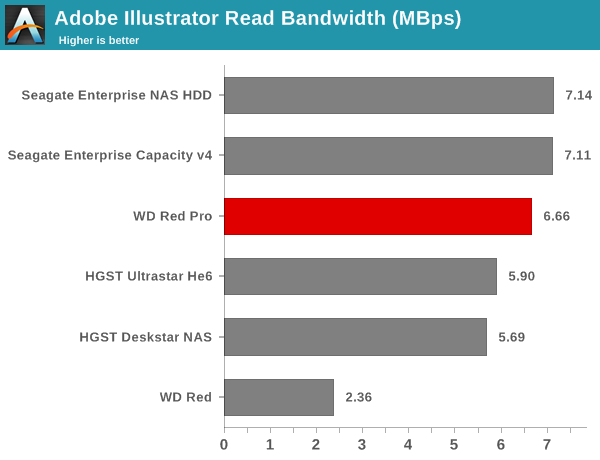
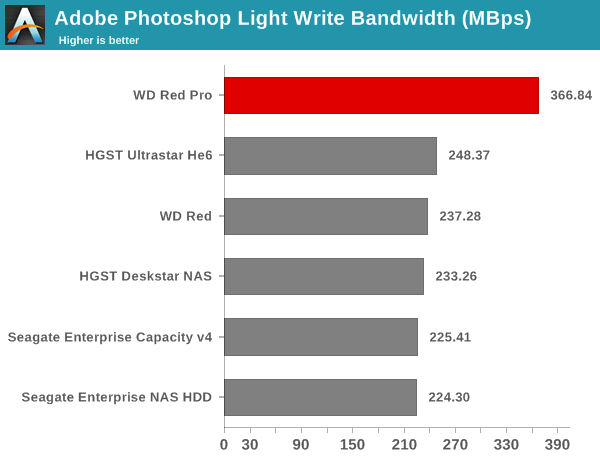
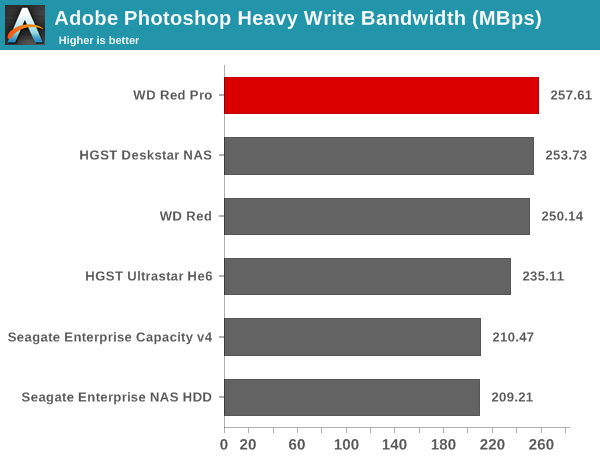

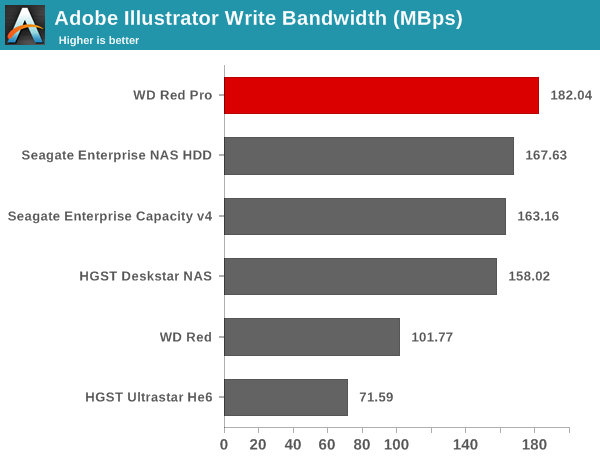
In the real-life workloads, the caching behavior enables the WD Red Pro to score better than the competitors in almost all the write tests. Read scenarios show it coming in the middle of the pack.
Single Client Access - NAS Benchmarks
Evaluation of single client performance in a networked environment was done by configuring three drives in RAID-5 in the QNAP TS-EC1279U-SAS-RP unit. Two of the network links were bonded (configured with 802.3ad LACP). Our usual Intel NASPT / robocopy benchmarks were processed from a virtual machine in our NAS testbed. The results are presented in the graphs below.
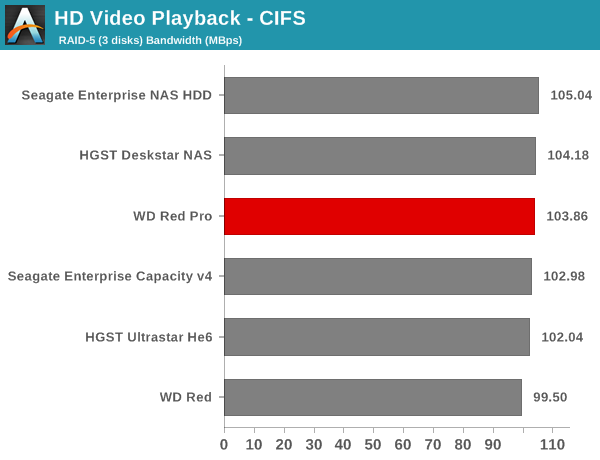
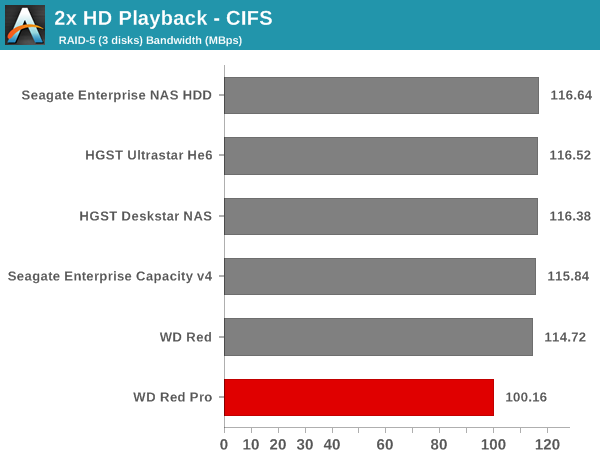

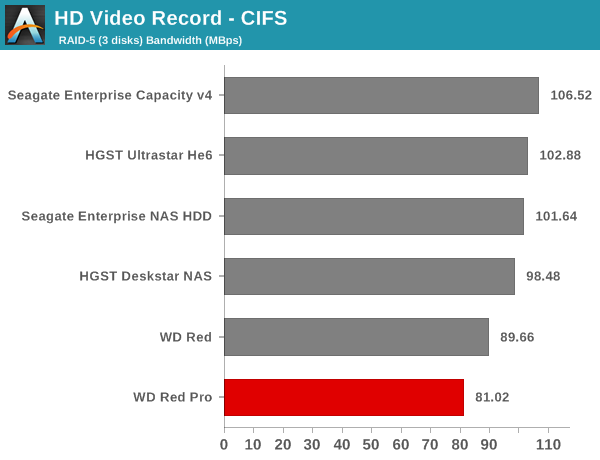
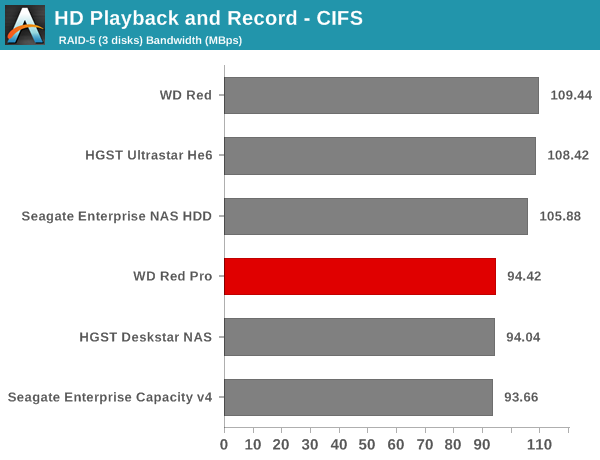

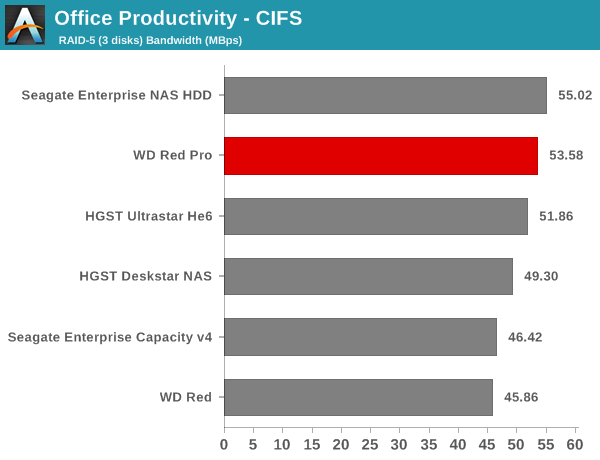
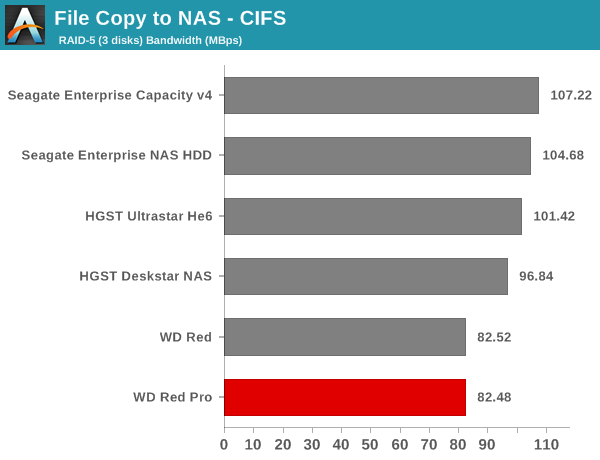
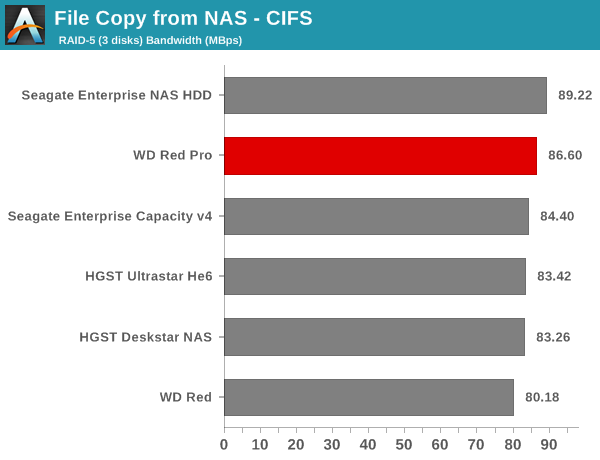
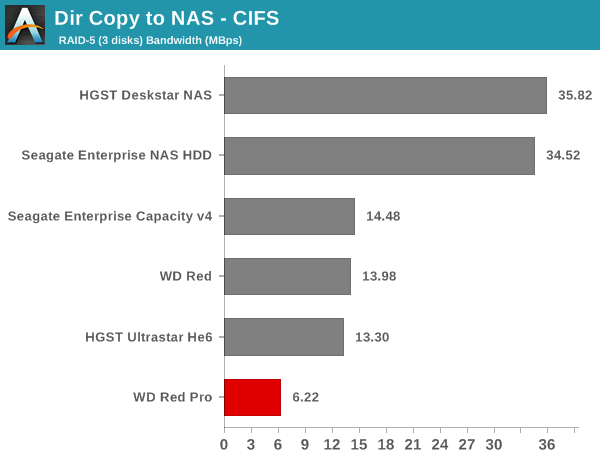
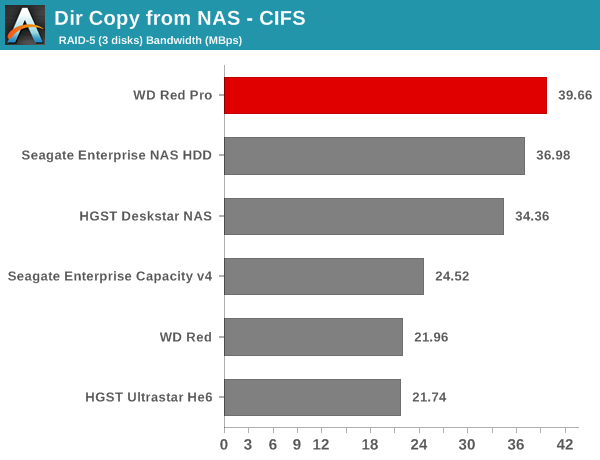
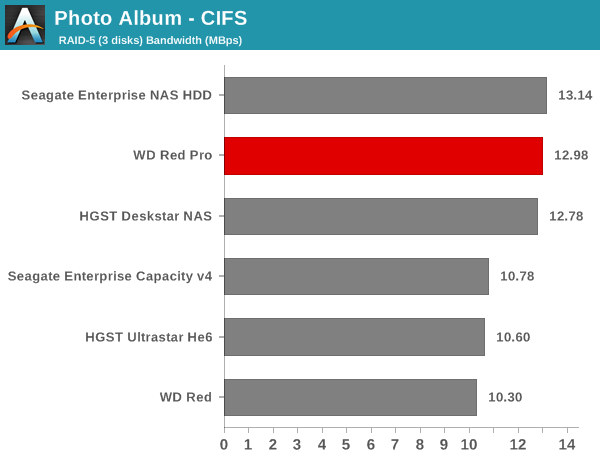
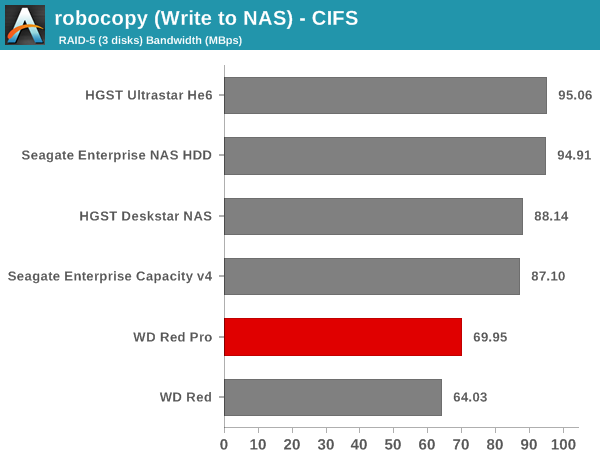
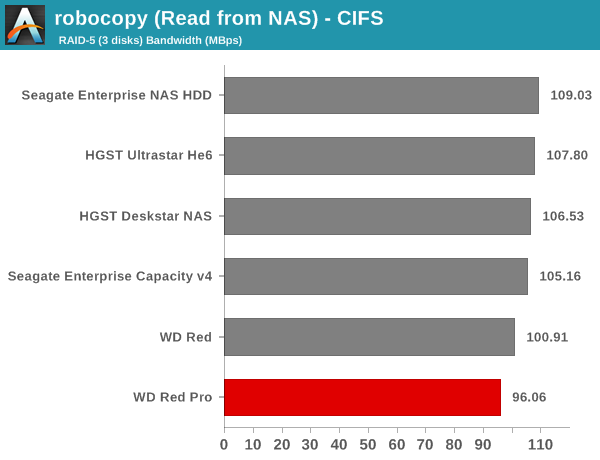
For almost all workloads, there is no discernible difference between the performance of various drives, indicating that it is the network acting as a bottleneck for single client access. Even when there are differences, it shows that certain drives are better suited for a particular type of workload compared to others. Differences start to appear when there are multiple clients accessing the NAS.
Multi-Client Access - NAS Environment
We configured three of the WD Red Pro drives in a RAID-5 volume in the QNAP TS-EC1279U-SAS-RP. A CIFS share in the volume was subject to some IOMeter tests with access from up to 25 VMs simultaneously. The following four graphs show the total available bandwidth and the average response time while being subject to different types of workloads through IOMeter. IOMeter also reports various other metrics of interest such as maximum response time, read and write IOPS, separate read and write bandwidth figures etc. Some of the interesting aspects from our IOMeter benchmarking run are available here.
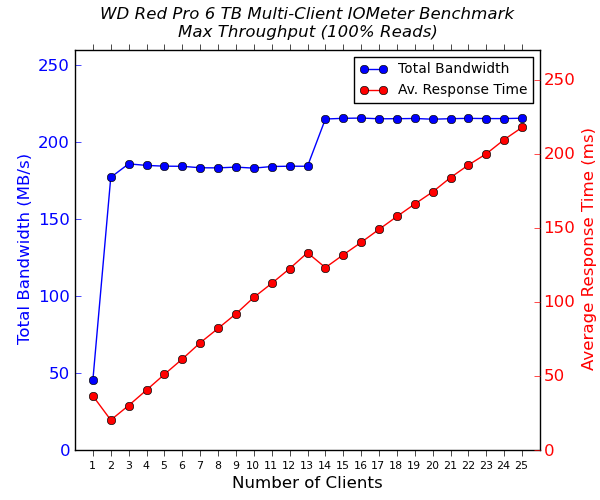
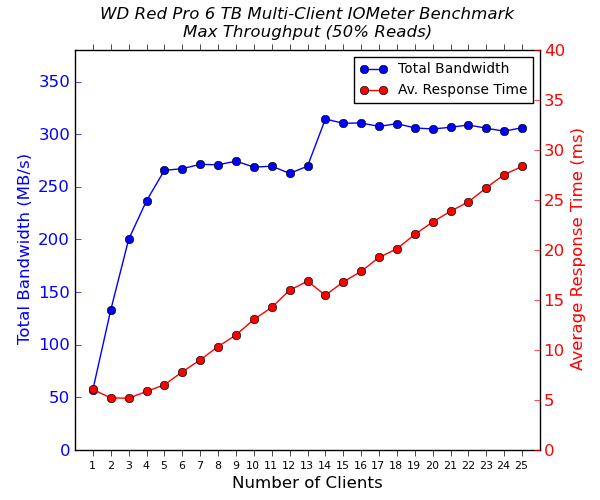

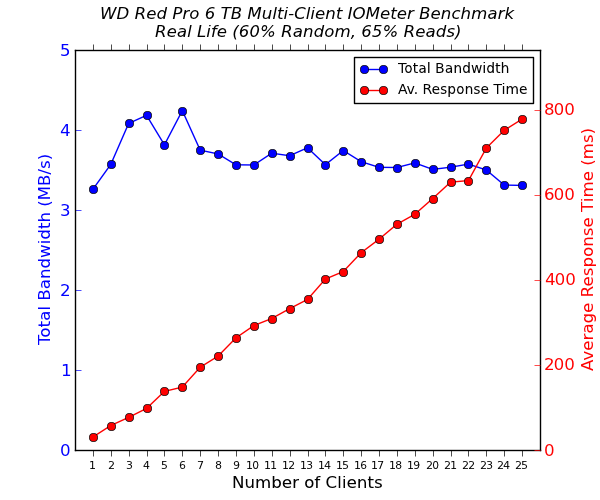
We see that the sequential accesses are still limited by the network link, but, this time, on the NAS side. The 100% sequential reads show similar results for all the drives. However, the WD Red Pro shows the best stability under stress from multiple clients for the 50% sequential reads / 50% sequential writes test. On the other hand, the Random 8K 70% reads sequence for the WD Red Pro show better numbers compared to the WD Red, but can't compete with the numbers from the other 6 TB drives. The 60% Random / 65% Reads sequence shows the WD Red Pro in better light compared to the WD Red and the HGST Deskstar NAS, but the other drives show consistently better numbers.
RAID-5 Benchmarking - Miscellaneous Aspects
Consumers are rightly worried about RAID rebuilds and the scope for drive failures during that process. As one of our evaluation aspects, we randomly yanked out a disk during operation and cleaned it up for rebuild. We recorded the resync duration (time taken to rebuild a 3-disk RAID-5 volume when one of the disks needs to be replaced) as well as the average power consumption during that process. The two aspects, considered together, give an idea of the efficiency of the hard drive. The graph below presents the total energy consumption (Resync Power Consumption (W) X Resync Duration (s)) for the resync.

While the energy consumption aspect provides a consolidated view of the various factors, it is still worthwhile to look at the power consumption and resync duration numbers separately. The table below provides the raw information behind the above graph. While the resync duration for the Red Pro is the lowest, the power consumption during the process was also the highest amongst all the evaluated drives. The nett result is that the drive comes in the middle of the pack when it comes to energy efficiency.
| RAID-5 Resync Power Consumption & Duration | ||
| Drive | Power (W) | Duration (s) |
| WD Red Pro | 111.9 | 35850 |
| Seagate Enterprise Capacity v4 | 105.42 | 37462 |
| Seagate Enterprise NAS HDD | 101.91 | 37284 |
| HGST Deskstar NAS | 101.46 | 36981 |
| HGST Ultrastar He6 | 95.36 | 45260 |
| WD Red | 90.48 | 52072 |
We also measured power consumption during the last stage of our multi-client test. With 25 different clients simultaneously stressing the NAS with different types of workloads, we recorded the power consumption at the wall for the NAS as a whole. The various numbers are presented in the graphs below.
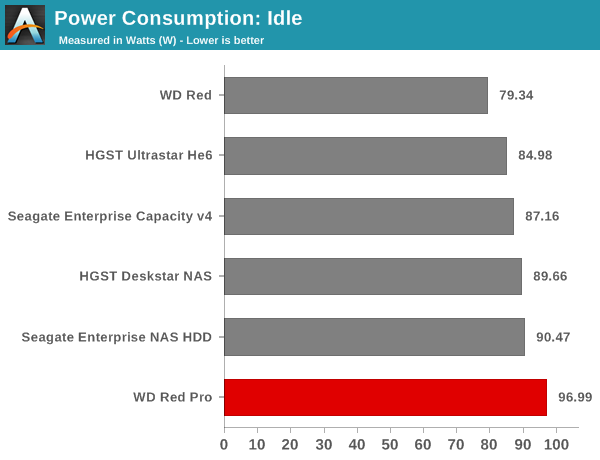



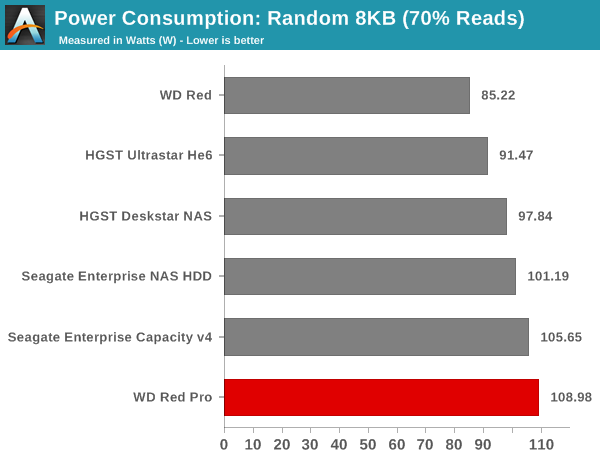
The WD Red Pro is simply not the most power-efficient NAS drive that we have evaluated. Except for the 5400 RPM WD Red, all the other drives that we have in the graphs above are 7200 RPM drives. Despite that fact, the WD Red Pro has the highest average power consumption for all our workloads. However, for a given fixed set of transactions, we expect that the energy efficiency of the WD Red Pro will not be at either extreme (similar to the RAID resync scenario).
Concluding Remarks
The Western Digital Red Pro is the latest addition to our 6 TB drives evaluation set. We have taken a look at how it compares against the other 6 TB drives that have been evaluated before in both DAS and NAS scenarios. It is hard to recommend any particular 6 TB drive as the clear cut choice unless the particular application is known. The various hard drives in the comparison lot were launched targeting different markets and their resulting performance varies accordingly. At the most, the Seagate Enterprise NAS HDD and the WD Red Pro fall under the same category. However, they each win out on different workloads, with the Seagate drive enjoying a slight edge.
Thanks to the 7200 RPM speeds, the WD Red Pro does manage to acquit itself well in the overall performance category. Though it is not the absolute best, it performs admirably well in the sequential access patterns segment of the multi-client evaluation.
The WD Red Pro doesn't deliver the lowest power consumption. Those were recorded, as expected, with the 5400 RPM WD Red and the HelioSeal-technology based HGST Ultrastar He6. However, the WD Red Pro provides a good balance between speed and energy efficiency.
The WD Red Pro 6 TB version is priced at $300. At this price, users can also purchase the HGST Deskstar NAS 6 TB (though Newegg has reduced pricing for multiple disks in this case). The Seagate Enterprise NAS HDD comes in at $305, while the Enterprise Capacity v4 version comes in around $450. The choice at the $300 price point for 1-16 bay NAS units comes down to the WD Red Pro and the Seagate Enterprise NAS HDD. As mentioned earlier, the choice depends on the expected workloads.

